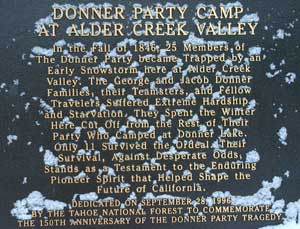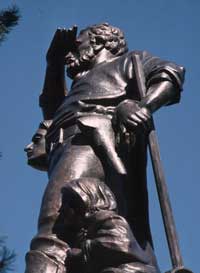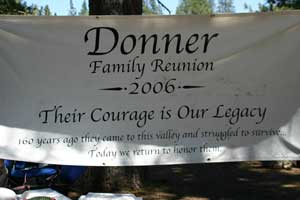|
The Donner Party: Lessons Learned
There were nearly 90 members in the Donner Company and 81 of them were trapped by snow at Donner Lake and Alder Creek during the winter of
1846-47. Nearly half of the pioneers died before it was all over. Although this event occurred more than 160 years ago, it is still a heart-rending story. Yet it helps us to understand how people cope with severe
hardship and seemingly insurmountable challenges.
The tragic lesson was not lost on California's pre-gold rush civilian population or on its interim government. Two years later, when
early winter storms battered the Sierra high country in October and November of 1849, the first year of the gold rush, California's military governor, Major General Persifer F. Smith
authorized $100,000 in emergency funding to finance relief teams for emigrants struggling along the Truckee and Carson trails, as well as the Lassen cutoff to the north.
Governor Smith was less concerned with starvation as most emigrants had sufficient provisions to reach California, but due to the
huge numbers of people on the trail that year, some would inevitably need food and general assistance. The main focus was on the lack of forage for the oxen and cattle that pulled the
wagons. If wagons had to be abandoned, it might backup the stream of emigrants trying to reach California before snow closed the pass for good. Teams of hired civilians and military
personnel were sent eastward with water and fresh livestock to strategic locations near the mountains and in the desert of present-day western Nevada to assist people trying to cross
the Sierra into California. Similar operations were conducted in 1850 and 1852 when large numbers of gold-seekers and inexperienced overland emigrants were entering the new state
. Never again would a wagon company be stranded in the high country without food or help.
After traveling the California Trail in 1846, T.H. Jefferson published a detailed trail map of the
route in 1849. Historian Dale Morgan considered it "one of the great American maps, an extraordinarily original production which will always have a special place in the cartography of the West." This Map of the Emigrant Road from Independence, Mo., to St. Francisco,
California, was sold in New York City for the stiff price of $3 a copy. The map, with its printed Accompaniment of eleven pages, was published early enough in the year that at
least one forty-niner, J. Goldsborough Bruff, carried a copy overland.
Included in the Accompaniment text is the following advice, no doubt inspired by the Donner party tragedy. "The most
difficult portion of the whole journey is the passage of the Californian Mountains, and particularly the descent of the western side. The only serious difficulty, however, is when
you arrive late in the season, with a short supply of bread stuff, and encounter snow ten or fifteen feet deep. Those who expect to cross in safety must reach the Truckey [Donner] Pass by the 1st of October. The snow does not
usually begin falling till November, and remains upon the ground more or less till May. If you arrive late, however, and encounter snow, do not attempt to cross the mountain,
but scatter at once into small parties and retreat to the eastern base of the mountains [Truckee Meadows], where you will find fertile valleys free from snow, which afford
game, salmon, and roots, enough for small parties. You can winter there, and cross at the Truckey Pass when the snow is gone."
The mortality rates among the members of the Donner party represent the physiological and
sociological differences between men and women, the strength of family groups and the age factor. In the Donner tragedy, females survived better than the males. Of the thirty-six who
perished in the mountains, twenty-seven were men and nine were women. In the Forlorn Hope snowshoe party of fifteen people, eight men died; two men and all five women survived
the long trek to safety. One of the reasons is that females are longer-lived than males and suffer less mortality across all age classes. Women also have less muscle mass and a
higher percentage of body fat (roughly 27% compared to about 15% in males). The fat is distributed in a larger proportion subcutaneously, which makes it an effective insulator. Two
thirds of the men died, while two thirds of the women survived.
According to Donner party research conducted by archaeologist Donald Grayson of the
University of Washington, women are twice as likely as men to survive extreme cold and hunger; more body fat, a lower metabolic rate and a temperament that is less prone to
aggression make women the hardier sex when it comes to surviving this kind of disaster. Of the thirty males who died, 13.3% died as a result of violence, but there is no convincing
evidence that any female member died violently. Family groups were important; all of the adult males who survived the entrapment (Breen, Eddy, Foster and Keseberg) were fathers.
Every one of the single, bachelors over the age of twenty-one died. Of the children under the age of five, 62.5% died; no adults over the age of forty-nine survived, except for Patrick
Breen who was fifty-one. The highest rate of survival was among children ages six through fourteen — of the twenty-one in that group, only two died.
One cause for the inordinate number of male deaths is likely the result of role expectations. Almost exclusively, the men were responsible
for cutting trees and breaking branches, gathering firewood, locating food, driving oxen and cattle, moving snow, repairing and sharpening large items and building shelters, along with other typically male duties. Once
they were snowbound in the mountains, these predominantly outdoor activities exposed the men to wet weather and cold temperatures, which contributed to evaporative heat loss and
sapped their energy. Many of the adult men paid the ultimate price for their sacrifice to the group; only 27% of them survived, while 67% of the adult women and 87% of the adolescents
lived. It's due to the courage, sacrifice and perseverance of the adult members of this pioneer party and their rescuers that nearly 90% of all the children survived to reach California. |




